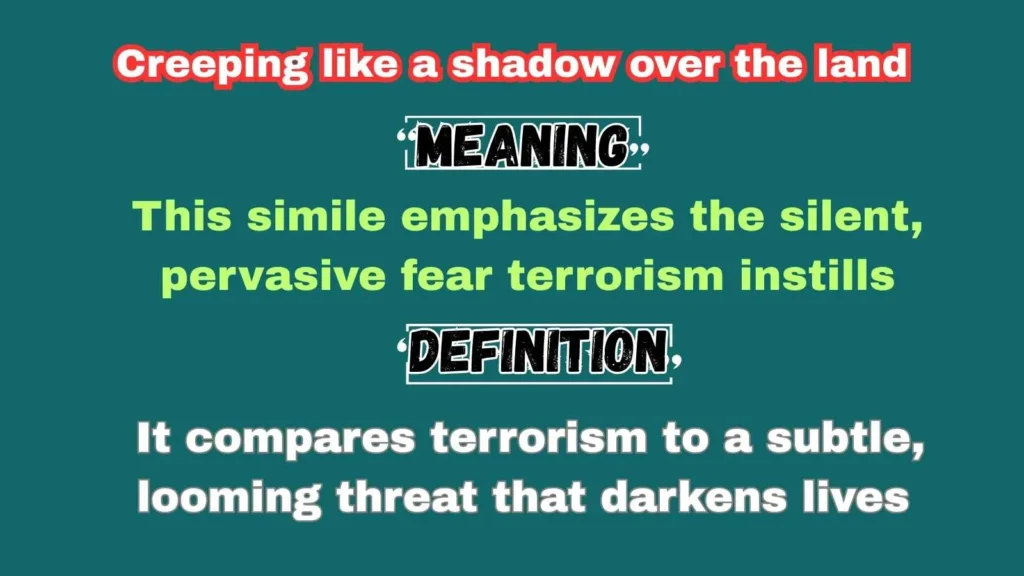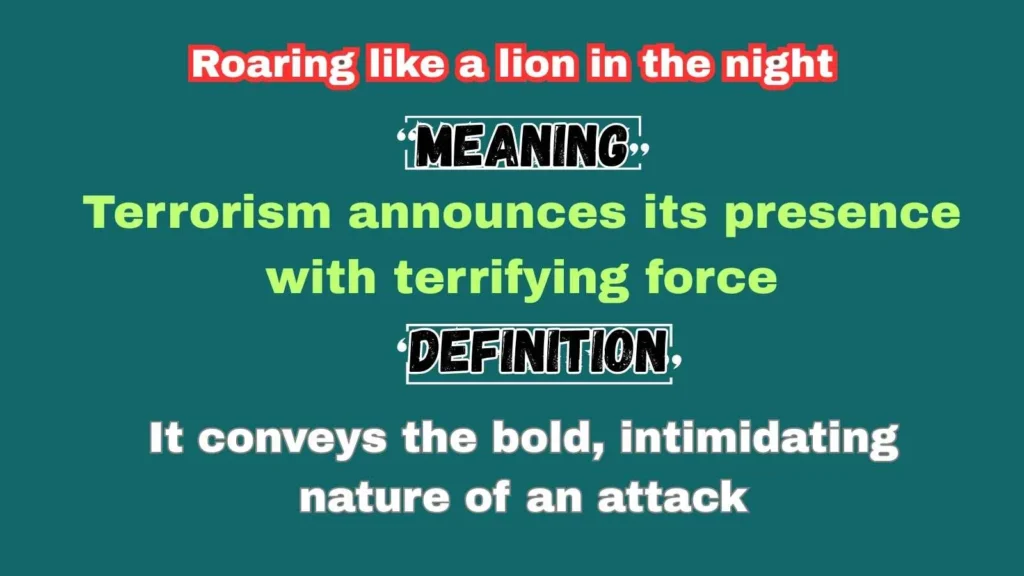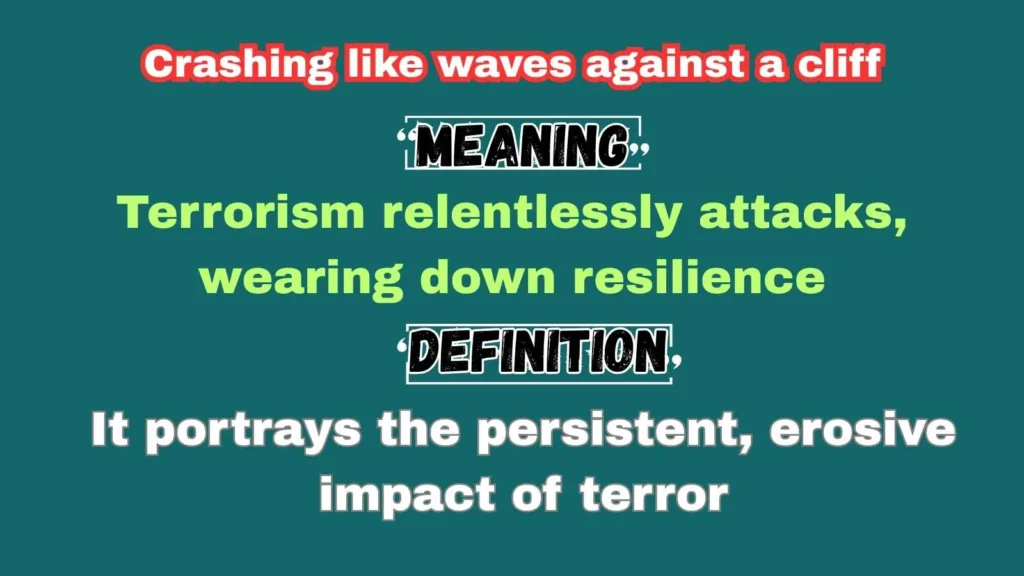Similes are a vibrant way to paint pictures with words, comparing two unlike things using “like” or “as” to spark imagination. Exploring similes for a complex topic like terrorism is compelling because it helps us articulate its chaos, fear, and impact in ways that resonate deeply.
These comparisons bridge raw emotion and vivid imagery, making abstract concepts feel real. Whether you’re a writer, poet, or student, this collection of carefully crafted similes will inspire you to express the gravity of this issue with clarity and creativity.
Read on to discover how these metaphors can transform your storytelling and captivate your audience with fresh perspectives.
Quick Definition of a Simile
A simile is a figure of speech that compares two different things using “like” or “as” to create vivid imagery. It simplifies complex ideas, making them relatable and engaging.
Table of 5 Quick Similes
| Simile | Meaning | Example Sentence |
|---|---|---|
| Terrorism is like a storm tearing through a village. | It causes sudden, widespread destruction. | The attack struck the city like a storm tearing through a village, leaving chaos in its wake. |
| Terrorism spreads like wildfire in a dry forest. | It escalates quickly and uncontrollably. | Fear spread like wildfire in a dry forest after the news of the attack broke. |
| Terrorism is like a shadow creeping over the land. | It instills quiet, pervasive fear. | The threat hung over the town like a shadow creeping over the land. |
| Terrorism strikes like a snake in the grass. | It is sudden and hidden until it attacks. | The explosion hit like a snake in the grass, catching everyone off guard. |
| Terrorism lingers like a foul odor in the air. | Its impact is persistent and unsettling. | The memory of the tragedy lingered like a foul odor in the air, haunting the survivors. |
Terrorism is like a storm tearing through a village
Meaning: This simile captures the sudden, destructive force of terrorism, leaving devastation in its path.
Definition: It portrays terrorism as an overwhelming, chaotic event that disrupts lives abruptly.
- Example 1: The bombing hit the marketplace like a storm tearing through a village, scattering debris and dreams.
- Example 2: Like a storm tearing through a village, the attack left the community struggling to rebuild.
Spreading like wildfire in a dry forest
Meaning: Terrorism can escalate rapidly, consuming everything in its path.
Definition: It highlights the uncontrollable and fast-spreading nature of terror.
- Example 1: Panic spread like wildfire in a dry forest as rumors of another attack surfaced.
- Example 2: The ideology of hate grew like wildfire in a dry forest, igniting fear across borders.
Creeping like a shadow over the land

Meaning: This simile emphasizes the silent, pervasive fear terrorism instills.
Definition: It compares terrorism to a subtle, looming threat that darkens lives.
- Example 1: The threat of violence hung like a shadow creeping over the land, chilling every heart.
- Example 2: Like a shadow creeping over the land, the fear of attack altered daily routines.
Striking like a snake in the grass
Meaning: Terrorism often attacks unexpectedly, catching victims unaware.
Definition: It depicts the hidden, sudden danger of terror acts.
- Example 1: The explosion struck like a snake in the grass, shattering the morning’s calm.
- Example 2: Like a snake in the grass, the attack came without warning, leaving devastation.
Lingering like a foul odor in the air
Meaning: The aftermath of terrorism persists, haunting those affected.
Definition: It illustrates the lasting, unpleasant impact of terror.
- Example 1: The grief from the tragedy lingered like a foul odor in the air, inescapable.
- Example 2: Like a foul odor in the air, the memory of the attack tainted every moment.
Roaring like a lion in the night

Meaning: Terrorism announces its presence with terrifying force.
Definition: It conveys the bold, intimidating nature of an attack.
- Example 1: The blast roared like a lion in the night, shaking the city to its core.
- Example 2: Like a lion in the night, the attack’s ferocity left everyone trembling.
Spreading like a virus in a crowd
Meaning: Terrorist ideologies can infect and spread rapidly.
Definition: It compares terrorism’s growth to a contagious disease.
- Example 1: Hateful rhetoric spread like a virus in a crowd, poisoning young minds.
- Example 2: Like a virus in a crowd, the extremist message infected vulnerable communities.
Crashing like waves against a cliff

Meaning: Terrorism relentlessly attacks, wearing down resilience.
Definition: It portrays the persistent, erosive impact of terror.
- Example 1: The attacks came like waves crashing against a cliff, testing the nation’s strength.
- Example 2: Like waves against a cliff, each incident chipped away at the community’s hope.
Burning like a fuse on a bomb
Meaning: The tension before an attack builds dangerously.
Definition: It highlights the escalating, inevitable threat of terrorism.
- Example 1: The city’s fear burned like a fuse on a bomb, waiting to explode.
- Example 2: Like a fuse on a bomb, the rising tension signaled an imminent attack.
Hiding like a wolf in sheep’s clothing
Meaning: Terrorists often blend in, masking their intentions.
Definition: It depicts the deceptive, covert nature of terrorism.
- Example 1: The attacker hid like a wolf in sheep’s clothing, unnoticed until the strike.
- Example 2: Like a wolf in sheep’s clothing, the plot went undetected until it was too late.
Exploding like a volcano’s wrath
Meaning: Terrorism unleashes sudden, catastrophic destruction.
Definition: It compares attacks to a violent natural eruption.
- Example 1: The bomb exploded like a volcano’s wrath, engulfing the square in chaos.
- Example 2: Like a volcano’s wrath, the attack left a trail of ruin and despair.
Stinging like a scorpion’s tail
Meaning: Terrorism delivers sharp, painful blows.
Definition: It conveys the acute, targeted harm of terror acts.
- Example 1: The attack stung like a scorpion’s tail, leaving the community in agony.
- Example 2: Like a scorpion’s tail, the strike was quick and brutally painful.
Swarming like locusts over crops
Meaning: Terrorism can overwhelm with rapid, collective destruction.
Definition: It likens attacks to a plague consuming everything.
- Example 1: The coordinated attacks swarmed like locusts over crops, devastating the city.
- Example 2: Like locusts over crops, the terrorists left nothing but destruction behind.
Chilling like a winter wind
Meaning: Terrorism instills deep, pervasive fear.
Definition: It compares the emotional impact to a biting cold.
- Example 1: The news of the attack chilled the nation like a winter wind.
- Example 2: Like a winter wind, the threat of terrorism froze the community in fear.
Raging like a river in flood
Meaning: Terrorism surges with uncontrollable force.
Definition: It portrays the overwhelming, chaotic power of attacks.
- Example 1: The violence raged like a river in flood, sweeping away peace.
- Example 2: Like a river in flood, the attack overwhelmed all defenses.
Sinking like a stone in water
Meaning: The impact of terrorism drags down hope and morale.
Definition: It illustrates the heavy, depressing aftermath of terror.
- Example 1: The community’s spirit sank like a stone in water after the tragedy.
- Example 2: Like a stone in water, the attack pulled the nation into despair.
Striking like lightning in a clear sky
Meaning: Terrorism hits unexpectedly, shocking everyone.
Definition: It highlights the sudden, unpredictable nature of attacks.
- Example 1: The explosion struck like lightning in a clear sky, stunning the crowd.
- Example 2: Like lightning in a clear sky, the attack came without any warning.
Spreading like poison in a stream
Meaning: Terrorist ideologies taint and corrupt gradually.
Definition: It compares the subtle spread of extremism to poison.
- Example 1: Hate spread like poison in a stream, corrupting vulnerable minds.
- Example 2: Like poison in a stream, the ideology tainted the community’s peace.
Crushing like a boulder on a path
Meaning: Terrorism overwhelms with immense force.
Definition: It depicts the heavy, destructive impact of terror acts.
- Example 1: The attack crushed the town like a boulder on a path, halting progress.
- Example 2: Like a boulder on a path, the tragedy blocked the road to recovery.
Fading like a nightmare at dawn
Meaning: The fear of terrorism can lessen over time but leaves scars.
Definition: It compares the lingering yet fading trauma to a dream.
- Example 1: The fear faded like a nightmare at dawn, but the pain remained.
- Example 2: Like a nightmare at dawn, the memory of the attack slowly receded.
Burning like a city under siege
Meaning: Terrorism creates intense, widespread destruction.
Definition: It likens attacks to a city consumed by conflict.
- Example 1: The marketplace burned like a city under siege, lost to chaos.
- Example 2: Like a city under siege, the attack left scars on every street.
Twisting like a knife in a wound
Meaning: Terrorism deepens pain with every act.
Definition: It conveys the ongoing, agonizing impact of terror.
- Example 1: Each new attack twisted like a knife in a wound, worsening the grief.
- Example 2: Like a knife in a wound, the tragedy deepened the community’s sorrow.
Scattering like leaves in a storm
Meaning: Terrorism disrupts lives, scattering people and plans.
Definition: It compares the chaos to leaves blown apart.
- Example 1: The attack scattered the crowd like leaves in a storm, creating panic.
- Example 2: Like leaves in a storm, families were torn apart by the tragedy.
Haunting like a ghost in the night
Meaning: The memory of terrorism lingers eerily.
Definition: It portrays the persistent, unsettling aftermath of attacks.
- Example 1: The tragedy haunted the town like a ghost in the night, never forgotten.
- Example 2: Like a ghost in the night, the attack’s memory lingered in every corner.
Erupting like a dormant volcano
Meaning: Terrorism can lie hidden before exploding violently.
Definition: It compares attacks to sudden volcanic eruptions.
- Example 1: The attack erupted like a dormant volcano, shocking the nation.
- Example 2: Like a dormant volcano, the threat exploded after years of silence.
Suffocating like smoke in a room
Meaning: Terrorism creates an oppressive, stifling atmosphere.
Definition: It likens the fear to choking smoke.
- Example 1: Fear suffocated the city like smoke in a room, making it hard to breathe.
- Example 2: Like smoke in a room, the threat of attack overwhelmed daily life.
Breaking like glass under pressure
Meaning: Terrorism shatters peace and stability.
Definition: It depicts the fragility of calm under attack.
- Example 1: The community’s peace broke like glass under pressure after the bombing.
- Example 2: Like glass under pressure, the nation’s unity cracked under the attack.
Spreading like ripples on a pond
Meaning: The effects of terrorism extend far beyond the initial act.
Definition: It compares the impact to widening ripples.
- Example 1: The attack’s fear spread like ripples on a pond, touching every life.
- Example 2: Like ripples on a pond, the tragedy’s effects reached distant communities.
Hitting like a hammer on an anvil
Meaning: Terrorism delivers powerful, resounding blows.
Definition: It conveys the forceful, jarring impact of attacks.
- Example 1: The explosion hit like a hammer on an anvil, shaking the city’s core.
- Example 2: Like a hammer on an anvil, the attack struck with unrelenting force.
Festering like an untreated wound
Meaning: The unresolved effects of terrorism worsen over time.
Definition: It likens the lingering trauma to an infected wound.
- Example 1: The community’s pain festered like an untreated wound, growing worse daily.
- Example 2: Like an untreated wound, the attack’s scars deepened with time.
Weaving Similes into Creative Writing
Similes are powerful tools for writers, adding depth and emotion to your work. Here’s how to use these terrorism-related similes effectively:
- Poetry: Use similes like “terrorism is like a storm tearing through a village” to evoke visceral imagery. Pair with vivid verbs to create rhythm, e.g., “It roars like a lion, shattering the night’s calm.”
- Stories: Incorporate similes to describe settings or emotions. For instance, “The town felt like a shadow crept over the land” sets a tense mood in a thriller.
- Songs: Similes add lyrical flair. “Spreading like wildfire in a dry forest” can become a haunting chorus line about chaos.
- Essays: Use similes sparingly to clarify complex ideas. “Terrorism strikes like a snake in the grass” can illustrate its unpredictability in analytical writing.
- Tips: Choose similes that match your tone, avoid overuse, and blend them naturally to maintain flow. Experiment with contrasts, like pairing destruction with beauty, to deepen impact.
FAQs
What is a simile in simple terms?
A simile compares two unlike things using “like” or “as” to create vivid imagery.
Why use similes for serious topics like terrorism?
Similes make complex emotions and events relatable, helping readers process and visualize the impact.
How can similes improve my writing?
Similes add color and clarity, making your writing more engaging and memorable.
Are these similes appropriate for all audiences?
Use them sensitively, considering your audience, as terrorism is a heavy topic.
Can I create my own similes for terrorism?
Yes, combine vivid imagery with emotional resonance to craft unique, impactful similes.
Conclusion
This collection of similes offers a powerful way to describe the chaos and fear of terrorism, transforming complex emotions into vivid imagery. Writers can use these comparisons to craft compelling stories, poems, or essays that resonate deeply.
Embrace these metaphors to bring clarity and creativity to your work, inspiring readers to see the world through a fresh, poignant lens.

